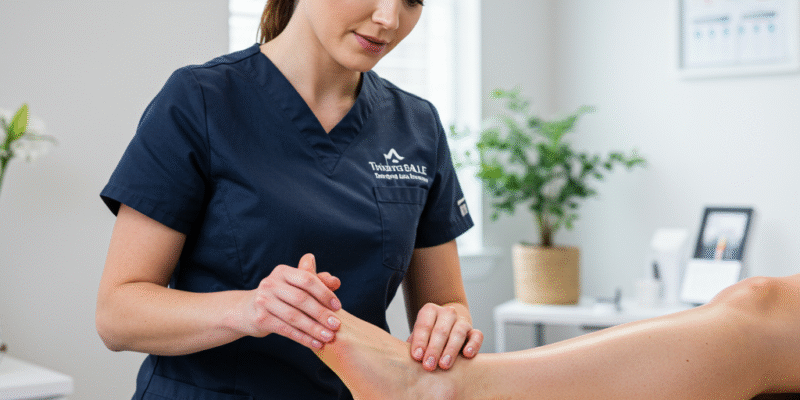Unpacking the Myth: Why “No Pain, No Gain” Harms Your Fitness Journey It’s a phrase we’ve all heard, echoing through gyms, sports fields, and even our own minds: “No pain, no gain.” For decades, this catchy motto has driven athletes and fitness enthusiasts to push their limits, believing that discomfort is a necessary precursor to progress. But what if we told you that this widely accepted wisdom is not only misguided but potentially harmful to your long-term health and fitness? Here at Recovery Rehab Physiotherapy in Australia, we see firsthand the consequences of this aggressive mindset. Our mission is to help Australians move better, feel stronger, and live healthier lives, and that often starts with debunking harmful myths like “no pain, no gain.” We believe that true, sustainable fitness comes from understanding your body, respecting its signals, and training smart, not just hard. In this comprehensive guide, we’re going to dive deep into why “no pain, no gain” is an outdated and dangerous concept. We’ll explore where it came from, the real dangers it poses, and most importantly, how you can achieve incredible fitness gains without constantly battling through unnecessary pain. Get ready to transform your approach to exercise and unlock a healthier, more sustainable path to your wellness goals. Where Did This Catchy (But Flawed) Mantra Come From? The phrase “no pain, no gain” isn’t new. Its roots are often traced back to bodybuilding and competitive sports culture, popularised in the 1980s by figures like Jane Fonda in her workout videos. The underlying idea was to encourage discipline, perseverance, and the understanding that significant results require effort. And in a way, that’s true. Building muscle, increasing endurance, or mastering a new skill certainly demands pushing past your comfort zone. Think about it: when you lift weights, your muscles need to be challenged beyond their usual capacity to adapt and grow stronger. When you run, your cardiovascular system needs to work harder to improve its efficiency. This initial “discomfort”—the muscle burn, the heavy breathing, the feeling of exertion—is a natural and often necessary part of the adaptation process. It signals that your body is being stimulated to change. The problem arises when this concept gets taken too literally. What started as a call for effort and consistency somehow morphed into an endorsement of ignoring genuine pain, leading many to believe that if exercise doesn’t hurt, it’s not working. This misinterpretation is where the danger truly lies, turning a potentially motivating phrase into a recipe for injury and frustration. The Dangerous Side of the “No Pain, No Gain” Mindset While the spirit of dedication is admirable, blindly adhering to “no pain, no gain” can steer you down a treacherous path. For many in Australia, particularly those just starting their fitness journey or returning after a break, this mindset can lead to serious setbacks. Ignoring Your Body’s Warning Signals Imagine your car’s dashboard: when the check engine light comes on, do you ignore it and keep driving, or do you investigate? Most likely, you’d get it checked out. Your body works in a similar way. Pain isn’t just an inconvenience; it’s your body’s sophisticated alarm system, a vital protective mechanism designed to tell you something is wrong or potentially about to go wrong. When you push through sharp, persistent pain, you’re essentially silencing that alarm. You’re overriding your body’s intelligent signals that are trying to prevent further damage. This could be anything from a strained muscle to an aggravated joint, and ignoring these warnings often turns minor issues into major injuries. At Recovery Rehab Physiotherapy, we empower our clients to *listen* to their bodies, distinguishing between healthy exertion and genuine injury signals. Increased Risk of Injury This is perhaps the most obvious and immediate danger. Consistently exercising with poor form, excessive weight, or inadequate recovery, all under the “no pain, no gain” banner, significantly increases your risk of injury. We’re talking about common issues like: * Muscle strains and tears: Pushing too hard when muscles are fatigued. * Ligament sprains: Overstretching or twisting joints beyond their normal range. * Tendonitis: Inflammation of tendons due to repetitive stress without proper recovery. * Joint pain: Cartilage wear and tear, or aggravation of existing conditions. * Stress fractures: Micro-cracks in bones from repetitive impact without adequate rest. These aren’t just minor inconveniences; they can sideline you from your fitness routine for weeks or even months. What’s worse, an acute injury, if not managed correctly, can develop into chronic pain, severely impacting your quality of life. Our physiotherapy services are frequently engaged to help individuals recover from injuries that could have been prevented if they had simply listened to their bodies. Burnout and Demotivation Beyond the physical risks, there’s a significant psychological toll. If every workout feels like a battle against pain, exercise quickly loses its appeal. Who wants to voluntarily put themselves through constant suffering? This relentless pursuit of discomfort can lead to: * Exercise aversion: You start dreading your workouts. * Lack of enjoyment: What was once a source of energy becomes a chore. * Mental fatigue: The constant focus on pain can be incredibly draining. * Quitting altogether: For many, the “no pain, no gain” mantra ultimately leads them to give up on their fitness journey entirely, feeling defeated and discouraged. Fitness should enhance your life, not make it miserable. A sustainable fitness routine is one you *enjoy* and can stick with consistently. Stalling Your Progress It seems counterintuitive, right? Pushing harder should lead to faster results. But if “no pain, no gain” leads to injury, then your progress will inevitably grind to a halt. An injury means: * Forced rest periods, leading to deconditioning. * Modifications to your routine, potentially limiting the exercises you can do. * Physical therapy sessions (though essential, they take time away from training). * A psychological battle to regain lost strength and confidence. True progress is consistent, gradual, and built on a foundation of health. One step back for every two steps forward isn’t progress; it’s a frustrating dance. Smart training, focused on injury prevention and proper recovery, ensures continuous forward momentum. Understanding “Good” Discomfort vs. “Bad” Pain This is the crux of the issue and where much of the confusion lies. Not all unpleasant sensations during exercise are the same. Learning to distinguish between productive discomfort and harmful pain is a game-changer for your fitness journey. What is “Good” Discomfort? Think of “good” discomfort as the sensation that tells you your body is working, adapting, and growing stronger. It’s a sign of exertion and challenge, not damage. These feelings are generally: * Muscle burn: That familiar burning sensation in your muscles during a challenging set, often due to lactic acid build-up. It usually subsides quickly once you stop the activity. * Muscle fatigue: The feeling of your muscles getting tired and weaker towards the end of a set or workout. * Heavy breathing/elevated heart rate: Your cardiovascular system working hard to supply oxygen to your muscles. * General soreness (DOMS): Delayed Onset Muscle Soreness, which typically sets in 24-48 hours *after* a workout. It’s a dull, aching sensation, often felt when you move the affected muscles, and it gradually fades. This is a sign of micro-trauma and subsequent repair, leading to stronger muscles. * A feeling of challenge: You’re pushing your limits, but it doesn’t feel sharp, sudden, or wrong. These sensations are temporary and indicate that your body is being stimulated in a positive way. They are the signals of adaptation and growth. Recognising “Bad” Pain Signals “Bad” pain is your body’s way of screaming for help. It’s a clear warning that something isn’t right and needs attention. Ignoring these signals is like ignoring a fire alarm – you’re putting yourself in danger. Look out for: * Sharp, stabbing, or shooting pain: Especially if it comes on suddenly during an exercise. * Sudden, acute pain: A feeling of something “popping” or tearing. * Pain that increases with movement: If a certain movement consistently makes the pain worse, stop. * Persistent pain: Pain that lingers long after your workout, or doesn’t improve with rest. * Pain accompanied by swelling, bruising, or redness: These are clear signs of injury. * Pain that causes you to alter your movement patterns: If you’re compensating or limping, it’s a problem. * Numbness or tingling: This could indicate nerve involvement and requires immediate attention. * Pain in a joint: Joint pain is generally more concerning than muscle soreness. Muscles are designed to stretch and tear (slightly, for growth), joints are not. If you experience any of these types of pain, it’s crucial to stop the activity and assess the situation. Often, seeking professional guidance from a qualified physiotherapist is the smartest next step. Here at Recovery Rehab Physiotherapy, we are experts in diagnosing and treating pain, helping you differentiate between what’s normal and what requires intervention. The Smarter Approach: All Gain, No Pain (or Minimal!) So, if “no pain, no gain” is out, what’s in? The answer is a far more intelligent, sustainable, and ultimately more effective approach to fitness that prioritises longevity, well-being, and consistent progress. We call it “All Gain, No (unnecessary) Pain.” Prioritise Proper Form and Technique This is the bedrock of safe and effective exercise. Poor form is a primary driver of injury, as it places undue stress on joints, ligaments, and muscles in ways they aren’t designed to handle. Think of it like building a house – a strong foundation (good form) is essential before you start adding more weight (load). * Quality over quantity: It’s always better to perform fewer repetitions with perfect form than many with sloppy technique. * Learn from the pros: Consider working with a qualified trainer or, even better, a physiotherapist like those at Recovery Rehab Physiotherapy, to assess and correct your movement patterns. We can provide personalised guidance to ensure you’re executing exercises safely and efficiently, reducing your injury risk and optimising your gains. Gradual Progression is Key Your body adapts over time, not overnight. Trying to do too much too soon is a direct path to injury and burnout. The principle of progressive overload is vital – gradually increasing the demands on your body – but it must be done intelligently. * Start slow: Especially if you’re new to exercise or returning after a break. * Increase load gradually: This could mean adding a small amount of weight, increasing reps, sets, or time, or reducing rest periods. * Listen to your body’s feedback: If you introduce a new challenge and experience persistent pain, scale back. There’s no shame in adjusting! * Analogy: Think of it like climbing a ladder, one rung at a time, rather than trying to jump to the top. Each rung is a small, manageable step that builds strength and confidence. Embrace Rest and Recovery Muscle growth and adaptation don’t happen in the gym; they happen *after* your workout, during rest. Ignoring recovery is like planting a seed but forgetting to water it. * Adequate sleep: Aim for 7-9 hours of quality sleep per night. This is when your body repairs tissues and releases crucial growth hormones. * Nutrient-rich diet: Fuel your body with the right protein, carbohydrates, and healthy fats to support repair and energy. * Active recovery: Gentle activities like walking, stretching, or foam rolling can promote blood flow and reduce muscle soreness. * Stress management: Chronic stress elevates cortisol, which can hinder recovery and muscle growth. * Physiotherapy for recovery: Our team at Recovery Rehab Physiotherapy offers treatments and advice to optimise your recovery, from manual therapy to exercise prescription, ensuring your body is primed for your next session. Listen Intently to Your Body This is perhaps the most critical skill to develop. Your body is constantly providing feedback; you just need to learn how to interpret it. * Self-awareness: Pay attention to how you feel before, during, and after exercise. * Adjust as needed: If you feel particularly fatigued or notice a niggle, it’s okay to reduce the intensity, switch exercises, or even take an extra rest day. It’s not a sign of weakness; it’s a sign of intelligence. * Ditch the ego: Don’t let pride push you into a risky situation. Your long-term health is more important than one heavy lift or fast sprint. The Power of Warm-ups and Cool-downs Often overlooked, these components are vital for preparing your body for activity and aiding recovery. * Warm-up: Prepares your muscles and joints for exercise, increases blood flow, and reduces injury risk. Dynamic stretches (like arm circles or leg swings) are excellent. * Cool-down: Helps bring your heart rate down, improves flexibility, and can reduce post-exercise soreness. Gentle static stretches are perfect here. When to Seek Professional Help (That’s Where We Come In!) While we advocate for listening to your body, sometimes the signals can be confusing, or an injury might require expert intervention. This is where professional physiotherapy becomes invaluable. If you experience pain that is: * Persistent: Doesn’t go away after a few days of rest. * Worsening: Gets worse over time or with activity. * Sharp or debilitating: Prevents you from performing daily activities or exercising safely. * Accompanied by other symptoms: Swelling, bruising, numbness, or weakness. Don’t push through it. Don’t “wait and see.” Ignoring these signs can lead to longer recovery times and more complex issues down the line. At Recovery Rehab Physiotherapy, based right here in Australia, we specialise in helping individuals navigate their fitness journey safely and effectively. Our experienced physiotherapists can: * Accurately diagnose the cause of your pain: We don’t just treat symptoms; we identify the root cause. * Develop a personalised treatment plan: Tailored to your specific injury, goals, and lifestyle. * Guide you through rehabilitation: Helping you regain strength, flexibility, and function safely. * Provide injury prevention strategies: Teaching you how to move optimally to avoid future problems. * Optimise your performance: Helping you achieve your athletic goals without compromising your body. Our goal is to get you back to doing what you love – whether that’s running a marathon, playing with your kids, or simply enjoying a walk – all without pain. We believe in empowering you with the knowledge and tools to take control of your physical well-being. Rewriting Your Fitness Story: A Mindset Shift It’s time to challenge the old narrative. Instead of viewing exercise as a battle you must endure, think of it as an investment in your health and well-being. A shift in mindset from “no pain, no gain” to “all gain, no (unnecessary) pain” can be incredibly liberating. Imagine a fitness journey where: * You look forward to your workouts because they feel good and energising. * You make consistent progress without constantly battling injuries. * You understand and trust your body’s incredible ability to adapt and heal. * You feel strong, capable, and resilient, both physically and mentally. This isn’t a fantasy; it’s an achievable reality when you adopt a smart, informed, and body-respecting approach to exercise. Embrace the “All Gain, No Pain” Philosophy Today! The “no pain, no gain” myth has been a harmful cornerstone of fitness culture for too long. It’s time to retire this outdated concept and embrace a more intelligent, sustainable, and ultimately more rewarding approach to physical activity. True strength and lasting fitness aren’t built on constant suffering but on consistent, smart effort, adequate recovery, and a deep respect for your body’s wisdom. Remember, genuine discomfort is a sign of challenge and adaptation, but sharp or persistent pain is a warning. Learn to tell the difference, listen to your body, and prioritise its well-being above all else. If you’re struggling with pain during exercise, or simply want to ensure your fitness routine is safe, effective, and sustainable, don’t hesitate to reach out. Here at Recovery Rehab Physiotherapy in Australia, our expert team is ready to support you. We’ll help you understand your body, overcome injuries, and develop a pain-free path to achieving your health and fitness goals. Ready to transform your fitness journey from pain to progress? Contact Recovery Rehab Physiotherapy today and let us help you achieve all your gains, with no unnecessary pain!



